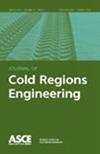与冰颗粒接触的毛细管桥可能与冰上的薄液膜有关
IF 1.1
4区 工程技术
Q3 ENGINEERING, CIVIL
引用次数: 0
摘要
:我们通过实验证明,在相对湿度约为 50%、温度低于熔点的条件下,冰粒与光滑铝表面接触处存在毛细管桥。我们在温度可控的冰柜中进行实验,并考虑了冰粒以恒定速度从铝表面分离时桥的机械不稳定性。我们观察到液桥的形成,当温度接近熔点时,液桥的形成更加明显。我们还发现,分离距离与液桥体积的立方根成正比。我们假设,液桥的体积可以用来粗略估计冰粒上液层的厚度,因为在没有其他驱动机制的情况下,表面上的一些液体一定被拉到了液桥区域。我们的研究表明,估计值在之前文献报道的范围之内。根据这些假设,估计的液层厚度从 T = - 1.7°C 时的近 56 nm 减小到 T = - 12.7°C 时的 0.2 nm。这种依赖关系可以用幂律近似表示,与 ( T M - T ) - β 成比例,其中 β < 2.6,T M 是熔化温度。我们进一步观察到,对于粗糙表面,毛细管桥的形成在所考虑的实验条件下会消失。doi: 10.1061/jcrgei.creng-738 .本作品采用知识共享协议(Creative Commons)条款发布。本文章由计算机程序翻译,如有差异,请以英文原文为准。
Capillary Bridge in Contact with Ice Particles Can Be Related to the Thin Liquid Film on Ice
: We experimentally demonstrate the presence of a capillary bridge in the contact between an ice particle and a smooth aluminum surface at a relative humidity of approximately 50% and temperatures below the melting point. We conduct the experiments in a freezer with a controlled temperature and consider the mechanical instability of the bridge upon separation of the ice particle from the aluminum surface at a constant speed. We observe that a liquid bridge forms, and this formation becomes more pronounced as the temperature approaches the melting point. We also show that the separation distance is proportional to the cube root of the volume of the bridge. We hypothesize that the volume of the liquid bridge can be used to provide a rough estimate of the thickness of the liquid layer on the ice particle since in the absence of other driving mechanisms, some of the liquid on the surface must have been pulled to the bridge area. We show that the estimated value lies within the range previously reported in the literature. With these assumptions, the estimated thickness of the liquid layer decreases from nearly 56 nm at T = − 1.7°C to 0.2 nm at T = − 12.7°C. The dependence can be approximated with a power law, proportional to ( T M − T ) − β , where β < 2.6 and T M is the melting temperature. We further observe that for a rough surface, the capillary bridge formation in the considered experimental conditions vanishes. DOI: 10.1061/JCRGEI.CRENG-738 . This work is made available under the terms of the Creative Commons
求助全文
通过发布文献求助,成功后即可免费获取论文全文。
去求助
来源期刊

Journal of Cold Regions Engineering
工程技术-地球科学综合
CiteScore
3.20
自引率
5.00%
发文量
23
审稿时长
>12 weeks
期刊介绍:
The Journal of Cold Regions Engineering publishes practice- and research-oriented articles from any area of civil engineering that is substantially related to cold regions. Topics include ice engineering, ice force, construction on permafrost and seasonal frost, cold weather construction, environmental quality and engineering in cold regions, snow and ice control, cold regions materials, and surveying and planning in cold regions.
 求助内容:
求助内容: 应助结果提醒方式:
应助结果提醒方式:


